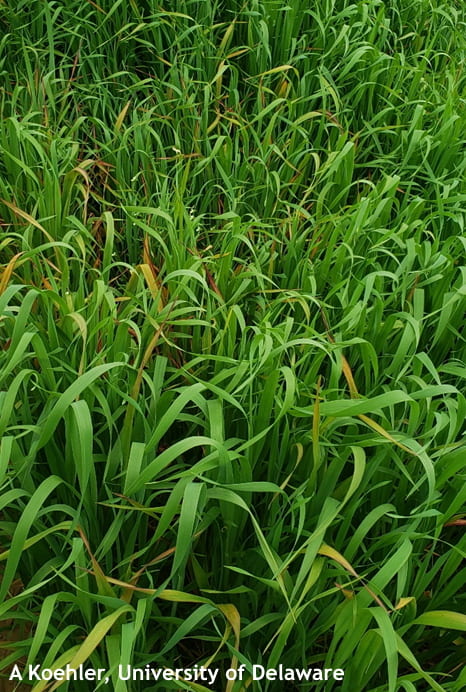Alyssa Koehler, Extension Field Crops Pathologist; akoehler@udel.edu
Across much of the region, barley is heading and wheat is at Feekes 9-10. There have been a few reports of scattered powdery mildew, but nothing at levels warranting a fungicide application. In a few fields, symptoms of potential Barley Yellow Dwarf Virus (BYDV) are becoming visible. Symptoms can include yellow to purple leaf discoloration, curling of the leaves, and stunting (Figure 1). Leaf discoloration begins at the tip and the color and level of symptom development can vary based on variety, weather, fertility, and a number of other factors. In wheat, early infections are typically associated with more stunting and red-purple to yellow leaves, while later infections tend to have yellow flag leaves without stunting. Aphids transmit BYDV, with most infection occurring in the fall and early winter. Fall infection is more damaging than infection of mature plants. Resistant varieties are available in oat, but there is only limited host resistance in barley and wheat. At this point in the season, spraying for aphids will not have an impact on disease levels.
Figure 1. Yellow to purple discoloration symptoms of Barley Yellow Dwarf Virus.
The Fusarium Risk Tool http://www.wheatscab.psu.edu/ has most of our region at low risk this week (Figure 2). If making a fungicide application in barley, the optimum stage to protect barley glumes from FHB is when the spike is fully emerged from the boot and florets are exposed (Figure 3). Unlike wheat, it is better to apply fungicides a little too early rather than too late in barley. In wheat, ideal application is Feekes 10.5.1., when yellow anthers are visible in the center of the spike. Application up to 4-6 days after anthesis in wheat will still provide FHB and DON control. We have had some cold nights this week. At heading/flowering wheat should be able to withstand temperatures of 28°F for two hours. Luckily, the temperatures were not below 32°F in most of our areas. Freeze damage at heading and flowering can cause sterility that impacts yield. Freeze damage can result in bleached, discolored heads, which is also the symptom we look for with FHB. Freeze damaged heads are often empty and deformed with distorted awns; heads with FHB will not be deformed.
Figure 2. Fusarium Risk Tool Prediction for April 16, 2020
Figure 3. Stages of barley at or near spike emergence, with the furthest right spike at optimum stage for fungicide application.



